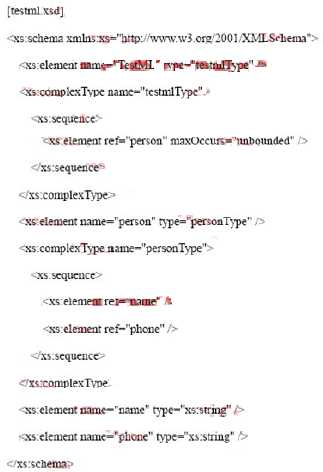Push the Exhibit Button to load the referenced "testml.xsd".

Assume that "testml.xsd" is defined. Without rewriting this XML Schema Document ("testml.xsd"), create a new, separate XML Schema Document to partially change the schema definition to write a cell Phone element as a child element of the person element. As a result, the following "XML
Document" will be valid against the new schema.
Which of the following correctly describes the new XML Schema Document? Assume the XML parser correctly processes the XML schema Location attribute.
[XML.Documet]
<TestML>
<person>
<name>John Smith</name>
<phone>03-000-999</phone>
<cellPhone>00-1111-2222</cellPhone>
</person>
</TestML>
- <xs:schema xmlns:xs="http://www.w3.org/2001/XMLSchema"> <xs:import schemaLocation="testml.xsd" />
<xs:complexType name="personType">
<xs:sequence>
<xs:element ref= " name " />
<xs:element ref= " phone " />
<xs:element ref= " cellPhone " />
</xs:sequence>
</xs:complexType>
<xs:element name= " cellPhone " type= " xs:string " /> </xs:schema> - <xs:schema xmlns:xs="http://www.w3.org/2001/XMLSchema"> <xs:include schemaLocation="testml.xsd" />
<xs:complexType name="newPersonType" substitutionGroup="personType"> <xs:sequence>
<xs:element ref= " name " />
<xs:element ref= " phone " />
<xs:element ref= " cellPhone " />
</xs:sequence>
</xs:complexType>
<xs:element name= " cellPhone " type= " xs:string " /> </xs:schema> - <xs:schema xmlns:xs="http://www.w3.org/2001/XMLSchema"> <xs:redefine schemaLocation= " testml.xsd " >
<xs:complexType name= " personType " >
<xs:complexContent>
<xs:extension base= " personType " >
<xs:sequence>
<xs:element ref= " cellPhone " />
</xs:sequence>
</xs:extension>
</xs:complexContent>
</xs:complexType>
</xs:redefine>
<xs:element name= " cellPhone " type= " xs:string " /> </xs:schema> - It is not possible to implement a function of the type proposed.